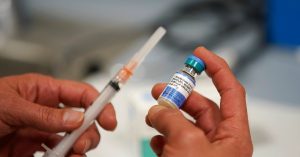

(© Joaquin Corbalan – stock.adobe.com)
In a nutshell
- Researchers discovered that a protein called AP2A1 acts as a master switch controlling whether cells behave young or old
- When scientists reduced AP2A1 levels in aged cells, they showed signs of rejuvenation, shrinking back to normal size and resuming division
- This discovery opens potential new approaches for treating age-related diseases like arthritis, heart disease, and dementia by targeting senescent “zombie” cells
Protein discovery could open new chapter in anti-aging research
OSAKA, Japan — In the ongoing battle against aging, scientists have discovered a surprising new player that might hold the key to keeping cells young or making them old. A recent study demonstrates how a protein called AP2A1 acts like a master switch, controlling whether cells behave like they’re in their prime or ready for retirement. This research shows that by manipulating just this one protein, scientists could potentially reverse cellular aging – essentially turning back the biological clock at the cellular level.
The study, conducted by researchers at Osaka University in Japan, focuses on what happens to human cells as they age. As we grow older, our bodies accumulate “senescent” cells – cells that have stopped dividing and entered a state of permanent growth arrest. These zombie-like cells don’t die, but they don’t function properly either. They grow abnormally large, produce inflammatory compounds, and contribute to age-related diseases ranging from arthritis to Alzheimer’s.
What makes this research particularly exciting is the discovery that by simply reducing the amount of AP2A1 in senescent cells, researchers could reverse many hallmarks of cellular aging. The rejuvenated cells shrunk back to normal size, resumed division, and showed other signs of youthfulness. Conversely, when researchers artificially increased AP2A1 levels in young cells, they prematurely displayed characteristics of old cells.
“These findings suggest that AP2A1 expression modulates cell states between senescence and rejuvenation,” the researchers write.
The mystery of senescent cells
To understand how significant this finding is, we need to look at what happens to cells as they age. Human cells can only divide a limited number of times before they enter senescence – a phenomenon first discovered in the 1960s by Leonard Hayflick, who found that human cells cultured in a laboratory would divide approximately 50 times before stopping permanently. This is known as the “Hayflick limit” and represents a fundamental aspect of cellular aging.


Senescent cells undergo dramatic changes. They swell in size – sometimes growing six times larger than young cells. They develop distinctive internal structures, particularly stress fibers – strands of protein that stretch across the cell like support beams. These fibers become thicker and more pronounced in aged cells. Senescent cells also produce less protein, move more slowly, and express specific genes associated with aging.
“We still don’t understand how these senescent cells can maintain their huge size,” says lead author Pirawan Chantachotikul in a statement. “One intriguing clue is that stress fibers are much thicker in senescent cells than in young cells, suggesting that proteins within these fibers help support their size.”
How human skin cells led to breakthrough
The Japanese research team made their discovery by studying human skin fibroblasts – cells that produce collagen and other components of connective tissue. They compared young fibroblasts (which had undergone few divisions) with older ones (which had divided many times and become senescent). Among many differences between the two cell types, they found that senescent cells had significantly higher levels of AP2A1.
AP2A1 — short for “alpha 1 adaptin subunit of the adaptor protein 2” — is primarily known for its role in clathrin-mediated endocytosis, a process by which cells internalize materials from their environment. Think of it as the cell’s recycling system for bringing materials inside. Until now, scientists hadn’t connected this protein to cellular aging.


Perhaps the most fascinating part of the study involved genetic manipulation experiments. When researchers reduced AP2A1 levels in senescent cells using a technique called RNA interference, the cells underwent a remarkable transformation. They became smaller, their stress fibers thinned out, they began dividing again, and they showed decreased expression of senescence-related genes. In essence, lowering AP2A1 levels rejuvenated the cells.
In the reverse experiment, increasing AP2A1 expression in young cells caused them to prematurely develop characteristics of senescence: they grew larger, developed thicker stress fibers, stopped dividing as frequently, and expressed genetic markers of aging.
Could scientists finally ‘reverse’ aging?
But how exactly does AP2A1 control cellular aging? The researchers discovered that AP2A1 appears to regulate how cells attach to their surroundings. Cells connect to their environment through structures called focal adhesions, which act like cellular anchors. In senescent cells, these focal adhesions become abnormally large and strong. The researchers found that AP2A1 helps transport a protein called integrin β1 along stress fibers to build and maintain these enlarged focal adhesions.
“FAs in senescent cells are not only augmented in size and molecular expression but also strengthened in terms of anchorage,” the researchers explained. This enhanced anchoring helps explain why senescent cells maintain their abnormally large size.
This discovery opens exciting possibilities for anti-aging medicine. If researchers could develop drugs that inhibit AP2A1 or its pathways, they might be able to rejuvenate senescent cells in the body, potentially slowing or even reversing aspects of aging. This approach could be particularly valuable for treating age-related diseases characterized by senescent cell accumulation, such as osteoarthritis, cardiovascular disease, and neurodegenerative disorders.
The findings, published in the journal Cellular Signalling, extend beyond simply understanding aging. Senescent cells play complex roles in our bodies. While they contribute to aging and age-related diseases, the senescence process also helps prevent cancer by stopping potentially dangerous cells from dividing. Any intervention targeting senescent cells would need to balance these considerations carefully.


The research team also confirmed that AP2A1 levels increase in other types of senescent cells, not just those that have reached the end of their replicative lifespan. When they exposed young cells to ultraviolet radiation or drugs that induce senescence, AP2A1 levels rose significantly. This suggests that AP2A1 upregulation is a universal feature of cellular senescence, regardless of what causes it.
Perhaps most intriguingly, the researchers found that AP2A1-related changes occur in different cell types. In addition to fibroblasts, they observed similar patterns in epithelial cells – cells that line the surfaces of organs and structures in the body. This indicates that AP2A1 might be a universal regulator of senescence across diverse cell types.
More than just a fountain of youth
The discoveries made in this study have potential applications beyond anti-aging medicine. Understanding how cells control their size and shape could help researchers develop new approaches to treating diseases characterized by abnormal cell growth, such as cancer. It might also provide insights into wound healing, where fibroblasts play crucial roles.
While the immediate applications focus on understanding and potentially reversing cellular aging, the long-term implications of this research could be far-reaching. By identifying AP2A1 as a key regulator of cell states between senescence and rejuvenation, scientists have uncovered a promising new target for interventions aimed at promoting cellular health and longevity.
The researchers concluded their study by highlighting AP2A1 as “both a promising biomarker and a therapeutic target for promoting cellular rejuvenation.” In the coming years, we can expect to see further research exploring how modulating AP2A1 activity might be used to treat age-related conditions and potentially extend healthy lifespan.
In the quest to understand aging, scientists have uncovered many individual pieces of the puzzle. This discovery of AP2A1’s role represents a significant advance, revealing a central control point that coordinates multiple aspects of cellular aging. By manipulating just this one protein, researchers may have found a way to tell cells whether to act young or old – essentially giving them the power to rewind the cellular clock.
Paper Summary
Methodology
Researchers at Osaka University conducted the study using primary human foreskin fibroblasts (HFF-1 cells), which were cultured and passaged repeatedly to induce replicative senescence. Young cells at passage 10 (P10) were compared to older cells at passage 30 (P30), which had undergone many more divisions and displayed senescent characteristics. The team employed a variety of techniques to analyze differences between young and aged cells, including immunofluorescence microscopy to visualize cellular structures, western blotting to measure protein levels, and live-cell imaging to observe dynamic processes within cells. They assessed senescence markers like SA-β-galactosidase activity, cell proliferation rates, and expression of cell cycle inhibitors including p53 and p21. To determine AP2A1’s role, they conducted knockdown experiments using small interfering RNA (siRNA) to reduce AP2A1 levels in senescent cells and overexpression experiments to increase AP2A1 in young cells. They also performed fluorescence recovery after photobleaching (FRAP) to analyze stress fiber turnover and used time-lapse microscopy to track the movement of proteins within cells. Additionally, the researchers validated their findings using other senescence models, including UV-induced and drug-induced senescence, and in different cell types like epithelial cells.
Results
The study revealed several key findings about AP2A1’s role in cellular senescence. First, AP2A1 expression levels increased significantly in senescent cells compared to young cells, both in whole cell lysates and in stress fiber fractions. Senescent cells exhibited characteristic changes including a 6.6-fold increase in cell size, flattened morphology, increased SA-β-galactosidase activity, and upregulation of p53 and p21. Their stress fibers became thicker and more stable, with reduced turnover compared to young cells. When AP2A1 was knocked down in senescent cells, many of these changes reversed: cells shrank, stress fibers thinned, senescence markers decreased, and cell proliferation increased – all signs of cellular rejuvenation. Conversely, overexpressing AP2A1 in young cells induced premature senescence characteristics. Further investigation revealed that AP2A1 colocalizes with integrin β1 along stress fibers, and both proteins move linearly along these fibers, with significantly slower movement in senescent cells. The researchers also found that focal adhesions were enlarged in senescent cells and exhibited stronger attachment to the substrate. Both UV- and drug-induced senescence models showed similar upregulation of AP2A1, as did senescent epithelial cells, indicating that AP2A1’s role in senescence extends beyond just replicative senescence in fibroblasts.
Limitations
The research, while groundbreaking, has several limitations worth noting. The study primarily used cultured human fibroblasts, which may not fully represent cell behavior in living tissues where cells interact with many other cell types and receive complex signaling. The findings need to be validated in animal models before clinical applications can be considered. Additionally, while the researchers demonstrated that manipulating AP2A1 levels affects senescence phenotypes, the full signaling pathways through which AP2A1 controls cellular aging remain to be elucidated. The study focused on cellular rejuvenation at the individual cell level, but didn’t address how AP2A1 manipulation might affect tissue function or organism-level aging. Furthermore, since senescent cells play important roles in wound healing and cancer prevention, simply eliminating them or reversing senescence could have unintended consequences that weren’t explored in this in vitro study. The research also didn’t address how AP2A1 levels might be safely manipulated in living organisms, which would be necessary for therapeutic applications.
Discussion and Takeaways
The discovery that AP2A1 modulates cell states between senescence and rejuvenation has significant implications for aging research and medicine. The study provides a mechanistic explanation for how senescent cells maintain their enlarged structure, revealing that AP2A1 helps coordinate integrin β1 transportation along stress fibers to strengthen cellular anchoring. This mechanism appears more efficient than random diffusion in large senescent cells. The researchers identified AP2A1 as both a potential biomarker for cellular aging and a promising therapeutic target. By manipulating AP2A1 levels, scientists might be able to reverse cellular aging or prevent age-related pathologies caused by senescent cell accumulation. The findings suggest new approaches to treating diseases associated with senescent cell accumulation, including neurodegenerative disorders, cardiovascular diseases, type 2 diabetes, and cancer. The research also enhances our fundamental understanding of cell biology, particularly how cells maintain their architecture and how this relates to their functional state. Since AP2A1 upregulation was observed in different types of senescence (replicative, UV-induced, and drug-induced) and in different cell types (fibroblasts and epithelial cells), it appears to be a universal feature of senescence, making it a robust target for intervention.
Funding and Disclosures
The research was partially supported by JSPS KAKENHI grants (21H03796 and 23H04929) and JICA (Japan International Cooperation Agency). The authors declared no competing interests or financial conflicts that might have influenced the study. The work was conducted at Osaka University in Japan, with collaborative efforts between the Division of Bioengineering, Graduate School of Engineering Science, the R3 Institute for Newly-Emerging Science Design, and the Global Center for Medical Engineering and Informatics.
Publication Information
The study titled “AP2A1 modulates cell states between senescence and rejuvenation” was published in the journal Cellular Signalling (Volume 127, 2025, Article 111616). The authors include Pirawan Chantachotikul, Shiyou Liu, Kana Furukawa, and Shinji Deguchi from Osaka University, Japan. The paper was received on October 27, 2023, received in revised form on December 31, 2024, accepted on January 18, 2025, and made available online on January 21, 2025. It was published under the CC BY-NC license.







